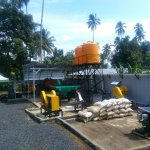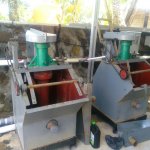- To participate in the 911Metallurgist Forums, be sure to JOIN & LOGIN
- Use Add New Topic to ask a New Question/Discussion about Gravity Separation/Concentration.
- OR Select a Topic that Interests you.
- Use Add Reply = to Reply/Participate in a Topic/Discussion (most frequent).
Using Add Reply allows you to Attach Images or PDF files and provide a more complete input. - Use Add Comment = to comment on someone else’s Reply in an already active Topic/Discussion.
Minimum gold Particle size that can be captured by Mercury during amalgamation (7 replies and 10 comments)
Hi,
why would you use amalgamation? If you are not worried by the safety and environmental issues related to mercury you should be worried that after 2020 it will be very difficult to buy mercury, as the international trade will be banned. Already now, in some countries, there are problems with mercury supply. So if you want to ensure your production you should think about alternatives and not use the old fashioned, dirty way of amalgamation. But- finally- the mercury problem in small scale gold mining will be coming to an end, not because the miners have finally learned that it is inefficient and agressive to their health and to the environment, but just simply because they will be running out of mercury soon.
Now to your question.
First: it is not to expect that your ball mill dischage will have a mininum size of 80 microns. If your top size is 500mm, you will have gold particles down to <20µm (which you will not get on a plate).
Second: do you talk about plate amalgamation or barrel amalgamation (of concentrates)?
A plate behind the mill will be much more inefficient than amalgamation of a gravity concentrate, and it would be a whole ore amalgamation, which definitely should not be used anymore. All your plate tailings would be contaminated with mercury and much gold ist lost to the tailings. How much gold will be glued on the plate surface depends on too many parameters to describe them here. Read Taggart, there everything is described.
If, at all, amalgamation should be used within the next hear and a half, you should amalgamate gravity concentrates in a barrel or mixer. There, only a small portion of the ore is contaminated. It is no problem to recover gold between 80 and 500 microns (and much finer, down to <20µm), if the gold surface and the mercury is clean. How to operate an amalgamation barrel can be found in literature, too.
The amalgam has to be burned in a retort, to recover the mercury.
It is useful to clean (after recovering the amalgam and liquid mercury from the concentrate) the rest on a shaking table, a small carpet sluice, by elutriation or/and by panning in oder to recover the floured mercury (which inevitably is produced). This cannot be re-used directly, you can add it to the retort.
Best regards
Hermann
Hi Hermann,
Your answer is very very Proffessional, I nformative and Environmentally responsible
You just don't know how many new Ideas I have gained from your answer.
To be Honest,
I have been (as I still am) following Conventional local ASM mining methods (plate amalgamation)..didn't know that Barrel amalgamation exists.
I also wasn't aware of the upcoming International ban on Trading Mercury by 2020.
May you please give me more clarification about the alternatives that should replace MERCURY in my mining activities?
Hermann, you are 100% right and this is a very relevant topic. There are literally millions of artisanal gold miners using mercury world wide. I am in Central America currently working with locals to upgrade their recovery methods but the main issue in this zone is the extreme fineness of the gold in the sulfide ores, - 500 mesh is common which is beyond the ability for practical recovery by mechanical means. We want to learn and teach cyanide extraction and test one of the new cyanide alternative leaches such as Eco-Goldex developed in Canada (we have a 25kg bag for testing). Why use an alternative to cyanide is simply because it's available for sale to the general public (in Canada or China) and there are no special shipping / handling / permitting requirements. Cyanide is not for sale to the public and never will be.
The priority project is to set up a 100 ton / week lixiviation operation for the community processing center, for whole ores and for mercury contaminated tailings. The ore dressing texts I find are highly technical and scaled for large operations. Can anyone assist or recommend where to get instructional information on how to set up a pilot scale leach operation but simplified methods on a low budget? I have donated some equipment to set up a lab and ability to assay and am learning about cyanide extraction. Thanks in advance!
Probably the simplest solution besides cyanidation is flotation.
We seem to get in the habit of forgetting what we have done in the past. And if it is not new it is not worth looking at. With alternatives to cyanide a hot topic, with proposals from glycine to fish sperm to thio-urea and others it may be time for a fresh look at an old (relatively) process, flotation. While gravity separation is often touted (include by yours truly) it does have its limitation, especially for fine gold and also for large tonnages.
Often over looked is that gold and silver (as native metals) are readily floatable using xanthates. And when they are of a more refractory nature (sulfide ores, telluride ores, and carbonaceous ores) or ores that contain cyanicides flotation can be used to recover the mineral or to remove the cyanicides.
When gold or silver are a secondary mineral (copper ores, lead-zinc ores, or such) the selectivity of flotation can be used (and has been used) for recovery.
There have been several successful operations that have used flotation for gold recovery in the past and the present:
•Bjorkdal, Sweden uses flotation for free-milling ore that was not recoverable by gravity process. It does use gravity for coarse gold recovery.
•Pamour Porcupine Mines, Schumacher Division uses flotation for copper sulfifed recover and to reduce the load on the leach circuit.
•El Indio, Chile used a primary flotation to remove cyanicides during grinding, and flowed grinding by flotation to reduce the load on the leach circuit.
Flotation is more complex than a straight cyanide leach, and takes more operational control. So why is flotation more complex than cyanidation? First the agitator is different as the goal is to mix and introduce air bubbles not just mix. Depending on the type of agitator you may (probably) need some low pressure blowers/compressors to supply the air bubbles. Then a froth collection system (launderers) is required at the top of the tank. But, compared to other processes, flotation is fairly simple.
Flotation is a proven method of recovering low grade ores (see copper) and as an alternative to cyanide it can work. So for your next large project try flotation!
A great perspective, you are right. What sources can you suggest to get basic info and equipment consultation about flotation methods? The engineering texts I have come across are all about big mining, written for other engineers. The mercury alternative evolution is about all the small and medium scale miners mostly in Latin American countries where there are literally hundreds of thousands of them hooked on crude amalgamation methods. I live in Costa Rica and travel throughout the region and see the mercury issues but I find almost no information available that these guys can actually understand and employ.
I would suggest starting here: https://www.smartdogmining.com/notebook/Intro%20to%20Froth%20Float.html
Of course 911 Metallurgist has information too, but IMHO mine is better ;{)
For small scale machines see: https://www.911metallurgist.com/equipment/flotation/
Hi Bubkwey - getting rid of mercury from artisanal operations will be a challenge as it is so easily available. Flotation is a great idea but probably too complex for the artisanal operators. Have a look at borax as a replacement for mercury. There is some info on the web. Cheers
Actually, if you have ever used a agitator washing machine and added detergent to it, you can run a flotatiion machine.
Borax (or ground glass) can be used as a flux ingredient when smelting gold ore concentrates. Borax is not a collector of gold, it does not amalgamate with gold. Borax is not a replacement for mercury as a collector (amalgamate) in whole ore processes nor creating or upgrading concentrates of ores.
Me too want to test and apply floatation prior to cyanidation.
My ore is a gold-copper. I read that you can float the gold or copper. Since doing direct cyanidation in a gold copper ore consume too much cyanide. So a treatment such as floation of the copper first is necessary.
Can anyone here want to help me or anybody here want to share information about floation.
I do also research the reagent needed for the floation circuit but i cant find a local supplier here in my country (Philippines) does anybody have? Can you send me few grams just for testing purposes.



below what size can't mercury trap gold from ore Milled By a ball mill ? Discharge size of milled ore is between 80 microns to 500 microns.